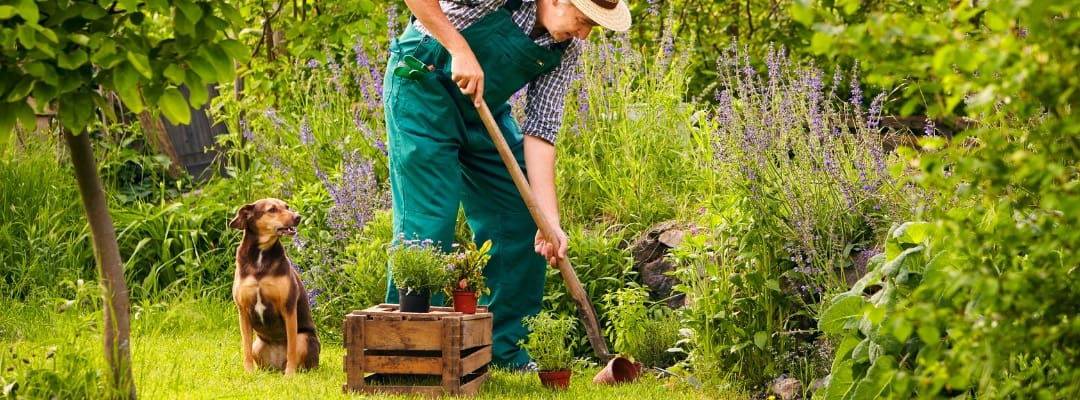Watching your lovely, well cared for plants slowly turn yellow and brown before succumbing to an untimely death is painful to witness, but that is exactly what will happen when your dog decides to “water” the plants for you.
So, does owning a dog mean saying goodbye to all your beautiful outdoor greenery? The answer is no, not if you take proactive steps to protect your treasured plants.
Need a solution to a dog peeing on your plants, ASAP?
- Remove the odor with a non-toxic odor eliminator like this one.
- Create a barrier to keep dogs out using metal U-posts , chicken wire, and a few heavy-duty zip ties for extra security.
- Add plants dogs don’t like such as Lemon balm, Citronella, Roses or Curry plants.
These are just a few ways to deter dogs. Keep reading to learn why dogs pee on plants and find the best solution for your particular situation.
How to Stop Dogs From Peeing on Your Plants
Because every dog is different, you’ll most likely want to test out a few of the following tips to see which ones your dog responds to. It may take some effort on your part, but it is possible to break your dog’s peeing habit, so don’t give up too soon.
Remove Existing Odor First
Dogs naturally tend to revisit the same general area to do their business. Their scent is already there which encourages them to go to that spot again and again. That’s why it’s important to remove as much of the urine and stool smells as possible to break the dog’s habit of using that particular location.
Water alone isn’t enough to totally wash away waste odors. You’ll want to use a product to destroy the smell at the source while causing no harm to the plants that your dog is targeting. After all, the poor plants are stressed enough as it is.
Simple Green Outdoor Odor Eliminator is a non-toxic formula that uses powerful, natural enzymes to eliminate odors. It can be applied directly to lawns and plants to quickly neutralize the smells that keep drawing your pet back to the same spot. This product can also be used to remove odors from patios, decks, brick or concrete walls and pathways, artificial turf, and more.
NaturVet Odor Eliminator Plus Citronella is another popular odor eliminator that can be sprayed on any outdoor surface including plants. The added citronella will not only leave behind a fresh, clean scent but will also discourage dogs from returning to the area as most dogs do not like the smell. As an additional bonus, the citronella may help to ward off pesky flies and mosquitoes from your yard as well.
If you’d prefer to avoid the hassle of dealing with a sprayer, we recommend Nature’s Pure Edge. Just sprinkle around problem areas and the crystalline structure of the small pellets will absorb bad odors. Composed of just two ingredients, zeolite and activated carbon, this all-natural yard odor eliminator is 100 percent safe to use around children, pets, and plants.
Install a Barrier Around Your Plants
Once all traces of urine have been eliminated from your plants, consider enclosing the garden area with a fence of some sort to keep your dog and neighborhood dogs away.
Setting up a safe enclosure around your garden can be as easy as pounding metal U-posts into the ground and hanging chicken wire onto the hooks of the post. For a bit of extra security, run a few heavy-duty zip ties through the top and bottom holes on each post being sure to catch at least one strand of chicken wire inside the tie before closing.
For a more elegant, yet still functional approach, install panels of decorative garden fencing. These are often made with pretty scrollwork or other designs across the top and are quick and easy to set up around the border of your garden.
Train Your Dog to Use a Designated Elimination Area
Setting aside a small portion of your yard for your dog to do his business, and then training him to use only that area might be a difficult but smart choice. I know it’s hard to give up a section of the yard that you’ve worked so hard to maintain over the years, but doing so might allow the rest of your yard to finally thrive.
There are a lot of advantages to training your dog to use the same area each time that he needs to relieve himself. Consider the following benefits:
- No more waiting and waiting for your dog to find the perfect spot to go potty. He’ll know right where to go already.
- No more watching with dismay as he relieves himself on your prized impatiens, again.
- No more wandering around the entire yard searching for smelly piles on poop clean-up day.
- No more accidentally stepping into a fresh pile of poo because they will no longer be strewn about the yard.
- No more being embarrassed when unexpected company drops by and your lawn is covered in dog droppings.
- No more unsightly yellow patches scattered all over your grass.
An outdoor privacy screen can effectively hide your dog’s new bathroom area from view and keep your backyard looking attractive.
Commercial Deterrent Products
Some gardeners have achieved great results from spray-on liquid deterrents like Liquid Fence, Go Away! Dog & Cat Repellent (Granules), Dog & Cat Boundary Spray, or Dog and Cat B Gon. A downside of these spray-on deterrents is that they usually must be reapplied after a rain shower.
Another option is to use repellent granules like Enviro Pro’s Scram For Dogs or Bonide’s Go Away Animal Repellent.
Like the liquid versions, the granules should be reapplied every few weeks and after heavy rainfall, but they are safe to use on and around plants and are simple to apply. Just shake out the granules around areas that your dog likes to target.
Homemade Deterrents
Most dogs do not care for strong smells. Use this to your advantage and create your own homemade repellent. You might go through a trial and error phase before discovering what works the best for your dog, but that’s okay as many homemade repellents are really inexpensive to put together.
Try a few of the following ideas, note which ones are most effective, and then combine them to produce the ultimate deterrent.
- Soak some cotton balls in vinegar, ammonia, or rubbing alcohol and place them around the plants you would like your dog to steer clear of.
- Scatter citrus peels throughout your garden area.
- Chop up several jalapeno peppers in a food processor (wear gloves to protect your hands), transfer to a quart-size jar, and fill to the top with water. Cap the jar and give it a good shake. After letting the mixture sit for a day or so, strain out the solid pieces, and pour the fluid into a clean plastic spray bottle. Spritz liberally around your plants. (This also helps to repel many harmful insects.)
- Sprinkle cayenne pepper around the base of plants.
- Fill a spray bottle with 1 ½ cups of water and add 20 drops of a citrus essential oil such as sweet orange or lemon and a couple of drops of dish soap. Shake gently and spray wherever your dog is destroying plants with urine.
- Spread your used coffee grounds at the base of plants. The grounds not only help repel dogs but also add nutrients to the soil and attract beneficial earthworms to the area.
Motion-Activated Sprinkler
Unless your dog loves to play in the water shooting out of a sprinkler, this motion-activated sprinkler by Hoont may work to protect your plants. The adjustable motion detector can pick up on movement up to 30 feet away and responds with a 5-second blast of water.
Simple to set up, this device attaches to a standard water hose and just needs to be placed in the desired location with the included metal stake. Multiple units can even be strung together to cover larger portions of your yard.
Sound-Emitting Deterrent Device
For those of you who don’t have any pets of your own but are wary of neighborhood dogs ruining your flower and vegetable beds, you may want to invest in a motion-activated pet repeller that uses ultrasonic sound and bright, flashing LED lights to banish pets from your yard.
The high pitched sounds and bright lights are effective for up to approximately 20 feet from the unit and won’t cause visiting animals any harm. The device simply makes the area very unpleasant to be around.
While most people can’t hear the ultrasonic noise, many animals can, including dogs, cats, squirrels, rabbits, rats, mice, and deer to name a few. So, you may be successful in deterring many common garden pests with this one device.
Have Your Dog Spayed or Neutered
Owners of sexually intact dogs are much more likely to find themselves dealing with scent-marking behaviors and a garden wasteland. Spaying a female dog prevents her from going into heat, a condition that often triggers marking behaviors.
When a male is neutered, the testes are removed, testosterone levels decrease, and the urge to mark any vertical object diminishes, sometimes disappearing completely.
Add Plants That Dogs Don’t Like
There are some plants that dogs tend to avoid. Interspersing a few dog repelling plants throughout your garden may help to keep your vegetables, flowers, and shrubs free of urine. Depending on the growing zone that you live in, try adding a few of these dog deterring plants to your landscape:
- Rue.
- Lemongrass.
- Lemon balm.
- Piss-off plant (also called Scaredy cat plant and Plectranthus caninus).
- Citronella.
- Roses or other thorny shrubs.
- Marigolds.
- Hot pepper plants such as Scotch bonnets.
- Curry plant.
Why Do Dogs Urinate on Plants?
Although territorial scent marking does occur in both sexes, if you’re seeing your upright plants wither and die, a male dog is likely to blame.
You see, a male dog’s instinct dictates that possessions (like your yard) need to be properly marked and labeled as his. If you spend some time closely observing a male dog, you’ll see that as soon as he encounters the urine of another dog (especially another male), he will go to great lengths to cover it with his own pee.
It’s almost as if he is saying, “Ha! My pee has wiped yours out and mine is just a bit higher than yours is. I am the winner!”
In the never-ending struggle to establish his supreme rule of the land, a male dog may view any upright object (yes, even your pretty plants) as fair game, especially if another dog is nearby.
Why Does Dog Pee Kill Plants?
Have you ever noticed how green and healthy your plants appear after a thunderstorm? If so, you have witnessed the effects of nitrogen, the most abundant element in the earth’s atmosphere. The lightning that occurs during storms breaks apart nitrogen bonds, causing nitrogen dioxide to be produced. This water-soluble form of nitrogen mixes with raindrops to form nitrates and fertilizes your plants.
So, what does that have to do with dog pee? Well, in small amounts, nitrates are quite good for your plants and lawn; in fact, all plants need nitrogen.
The problem is that the urea and uric acid found in dog urine (and people’s too) have a large concentration of nitrogen. In the case of plants, too much of a good thing can be fatal. All that nitrogen burns foliage and roots, and the stressed plants struggle to recover.
Both male and female dogs can damage plants and lawns. Although males usually distribute urine over a broad area while dashing around marking their territory, the concentration of nitrates and salts is typically greater than what is found in female urine.
Females, however, usually fully empty their bladder in one spot, thus dousing a small area with a relatively large amount of urine.
Related Tips
Whenever you catch a dog urinating on your plants or neatly manicured lawn, water the affected area thoroughly to dilute the concentration of harmful urea. Though this technique is not a complete fix, it will help to minimize the damage and reduce the amount of stress placed on foliage.
Keeping your dog well hydrated is another way to reduce the negative impact that dog urine has on susceptible plants and grasses. The more diluted the urine is, the better.
Last update on 2024-04-25 at 15:41 / Affiliate links / Images from Amazon Product Advertising API






